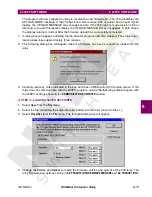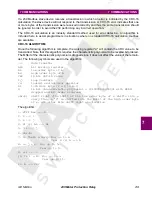
7-2
239 Motor Protection Relay
GE Multilin
7 COMMUNICATIONS
7 COMMUNICATIONS
7
7.4 DATA PACKET FORMAT
A complete request/response sequence consists of the following bytes (transmitted as separate data
frames):
Master Request Transmission:
SLAVE ADDRESS -
1 byte
FUNCTION CODE -
1 byte
DATA
variable number of bytes depending on FUNCTION CODE
CRC
2 bytes
Slave Response Transmission:
SLAVE ADDRESS -
1 byte
FUNCTION CODE -
1 byte
DATA
variable number of bytes depending on FUNCTION CODE
CRC 2
bytes
•
SLAVE ADDRESS: This is the first byte of every transmission. This byte represents the user-
assigned address of the slave device that is to receive the message sent by the master. Each
slave device must be assigned a unique address and only the addressed slave will respond to a
transmission that starts with its address. In a master request transmission the SLAVE ADDRESS
represents the address of the slave to which the request is being sent. In a slave response trans-
mission the SLAVE ADDRESS represents the address of the slave that is sending the response.
Note: A master transmission with a SLAVE ADDRESS of 0 indicates a broadcast command.
Broadcast commands can be used only in certain situations; see APPLICATIONS for details.
•
FUNCTION CODE: This is the second byte of every transmission. Modbus defines function
codes of 1 to 127. The 239 implements some of these functions. See section 3 for details of the
supported function codes. In a master request transmission the FUNCTION CODE tells the slave
what action to perform. In a slave response transmission if the FUNCTION CODE sent from the
slave is the same as the FUNCTION CODE sent from the master then the slave performed the
function as requested. If the high order bit of the FUNCTION CODE sent from the slave is a 1
(i.e. if the FUNCTION CODE is > 127) then the slave did not perform the function as requested
and is sending an error or exception response.
•
DATA: This will be a variable number of bytes depending on the FUNCTION CODE. This may be
Actual Values, Setpoints, or addresses sent by the master to the slave or by the slave to the mas-
ter. See section 3 for a description of the supported functions and the data required for each.
•
CRC: This is a two byte error checking code.
7.5 ERROR CHECKING
The RTU version of Modbus includes a two byte CRC-16 (16 bit cyclic redundancy check) with every
transmission. The CRC-16 algorithm essentially treats the entire data stream (data bits only; start,
stop and parity ignored) as one continuous binary number. This number is first shifted left 16 bits and
then divided by a characteristic polynomial (11000000000000101B). The 16 bit remainder of the divi-
sion is appended to the end of the transmission, LSByte first. The resulting message including CRC,
when divided by the same polynomial at the receiver will give a zero remainder if no transmission
errors have occurred.
Summary of Contents for 239
Page 2: ......
Page 4: ......
Page 16: ...1 10 239 Motor Protection Relay GE Multilin 1 OVERVIEW 1 OVERVIEW 1 ...
Page 104: ...6 14 239 Motor Protection Relay GE Multilin 6 239PC SOFTWARE 6 239PC SOFTWARE 6 ...
Page 150: ...8 10 239 Motor Protection Relay GE Multilin 8 TESTING 8 TESTING 8 ...
Page 152: ...A 2 239 Motor Protection Relay GE Multilin A 1 239 WARRANTY APPENDIX A A ...
Page 157: ...GE Multilin 239 Motor Protection Relay NOTES ...
















































